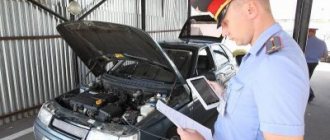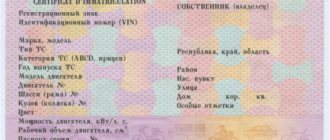What documents are needed to register a used car?
An application and documents can be submitted to the traffic police department by both the citizen himself and his representative with a power of attorney. The law also provides for sending documents by email or regular mail. What is included in the standard package of documents:
- Application in a single copy. It can be filled out by hand or prepared in printed form. The form indicates the traffic police department that accepts the application, the applicant’s full name, the name of the required service, information about the vehicle, information about the owner’s representative and the owner of the car. Learn more about how to fill out the application.
- Applicant's passport. It must contain a mark indicating registration on the territory of the Russian Federation, or a registration certificate must be attached.
- Birth certificate. In the event that the owner of the car is less than 14 years old.
- Vehicle passport and its photocopy.
- Transit number (if available). It is issued when purchasing a car in another region or city.
- Any document confirming ownership of the car (for example, a car purchase and sale agreement).
- OSAGO insurance.
- Receipt for payment of state duty.
We have listed the required documents for registering a car. Depending on the circumstances, additional information from the car owner may be required.
Inspection of the car itself
What are they looking at? This question interests almost everyone, without exception, who registers a car, especially those who do it for the first time. But the devil is not as terrible as he is painted. Don't panic ahead of time.
The main reason for refusal of registration during inspection is a violation of the vehicle’s design. What it is? You've probably seen a lot of low-slung cars with huge alloy wheels protruding from under the fenders, a roaring muffler and other technical innovations.
To be honest, I myself am a big fan of beautiful styling, but unfortunately the law prohibits a lot. The requirements have become especially strict this year.
Therefore, dear friends, when choosing a car, you don’t need to be led by beautiful wheels or the pleasant bass rumble of the engine. Be objective in your choice, this will help you save time and money. Well, if it so happens that you still become the owner of a car that is not quite “correct”, from a technical point of view, then this too can be corrected so that you can register without problems. First, let's understand what the inspector will look at in the car:
- — verification of VIN code, body and chassis numbers with documents
- - degree of glass tinting
- — compliance of the steering mechanism with factory parameters
- — compliance of the front and rear headlights with the car model and GOST.
These are, perhaps, the main requirements that may serve as a refusal to register your vehicle. Of course, you should not forget about gas equipment; if it is installed on the car, then permitting documents must be available; the inspector has the right to demand them from you. And the presence of a first aid kit, anti-roll bars and a warning triangle is now being checked for maintenance.
What is not included in the standard list of documents
Let's consider cases when the standard package is not enough:
- If the car is registered by a representative of the owner, then a power of attorney must be provided to the traffic police.
- If the car belongs to a diplomat or consul, then you need a card from international organizations. This is a document confirming international activity and issued to each international employee.
Also, when deregistering a car in case of disposal, traffic police officers now have the right to request a certificate confirming the fact of disposal of the vehicle.
Motor inspection
Separately, I would like to note the inspection of the engine. At the moment, the engine is not a mandatory inspection element, and most likely they will not look at its number. But here’s what you need to understand: if your car is not equipped with a “native” engine, but, for example, a more powerful one from another manufacturer, then you will also be denied registration; there have already been similar cases.
When buying a car, pay attention to the engine; if you have any doubts about the technical condition of the car, negotiate with the seller, take it for service, or better yet, look at other options. The secondary market is now overflowing with a huge number of different cars; you definitely won’t be left without a car.
Friends, be extremely careful when buying a car. It’s better to choose, as they say, a “naked” car, let it be on stock wheels, with a factory engine, without tinting, and of course, legally clean. And then you won’t have any problems with registration.
If you liked the article, I suggest you subscribe to blog updates to stay up to date with the latest automotive topics.
Share this post
- Related Posts
- Which is better to buy a thickness gauge for inspecting a car?
- General power of attorney for a car: pros and cons
- Car rental agreement
- How to check a car's equipment by VIN code
- Car resellers - principles and schemes of their work
- How to inherit a car
How to fill out an application for vehicle registration for individuals
One of the most important documents that must be provided to the inspector is the application. In this document, the new owner of the car asks to register his vehicle. It is enough to complete the application in one copy. This can be done on a simple sheet of paper, either by hand or on a computer. Car owners also have the opportunity to write an application using the State Services portal. Particular attention must be paid to the correctness of data entry. This is explained by the fact that if any errors or inaccuracies are identified, the inspector has the right to refuse to carry out registration actions. You can usually obtain an application form from traffic police departments. Its filling can be divided into several stages:
- The top line indicates the name of the traffic police department where you applied. To avoid mistakes here, the exact name can be found on the official website of the inspection.
- Below is detailed information about the applicant. It also indicates what actions need to be taken, namely, registered or registered.
- In the form you will see a block intended for entering detailed information about the vehicle. It is recommended to copy all data from documents.
- There is also a block where you need to enter the passport details of the owner of the equipment.
- If the interests of the car owner are represented at the traffic police department by a trusted person, information about him must be entered in a special block. If the registration is carried out by the owner himself, this block remains blank.
- There should be a number at the bottom. Moreover, it is not the date of preparation of the document that is indicated, but the date of its submission. The signature of the applicant is also required here.
Sample of filling out an application to the traffic police to register a car
Where can I get an application form to register a car?
The most common option is to obtain the form directly from the traffic police department.
However, there are also more modern options. For example, you can visit the official portal of the traffic police. Applications can be submitted in electronic format here. After simple mouse actions, the document will be saved on your computer. You can fill it out immediately and then print it out. In addition, the form can be downloaded on the State Services website. To do this you will need to register. Although it must be said that almost all modern drivers have been registered on this portal for a long time. On the main page you can see a list of services that can be performed on the site. Here you need to select “Transport and driving”, and then “Vehicle registration”. Then you should read detailed information about this service. By visiting the “Documents” section, you can see the entire list of documents that are required when registering. By selecting “Registration Application”, a template of the form you need will appear on the screen. After that, you just need to save it to your PC.
It must also be said that you can find sites on the Internet where these templates are freely available. With one click you can download them to your computer. However, many experienced drivers refuse to use such forms. This is explained quite simply. Practice shows that such documents can be adjusted over time. In other words, some minor changes may be made here. Without knowing this, the driver uses the old form, and when submitting documents it turns out that it is invalid. Therefore, you should only visit the official websites of the competent authorities. This is where you can always download the latest forms.
Registration actions with a car: how to remove and register a car
In Russia, by law, the vast majority of vehicles must have state registration plates. They confirm the fact that the car is registered and has an official owner. Let's try to figure out who should register what, within what time frame, with what documents and in what authorities.
The main regulations governing the registration of vehicles are Order No. 1001 of the Ministry of Internal Affairs of the Russian Federation dated November 24, 2008 “On the procedure for registering vehicles” and the administrative regulations of the Ministry of Internal Affairs, approved on August 7, 2013 by Order No. 605. The documents describe everything in great detail procedures. In addition, after their adoption, registration actions became much easier.
Registration of a vehicle with the traffic police department “links” a specific car with a specific individual or legal entity. The state knows who to send fines for traffic violations and issue an invoice from the tax office. In this case, any person authorized to drive by the owner can use the car.
What needs to be registered
It is necessary to register all vehicles and trailers for them intended for driving on public roads, and this, in accordance with the Law “On Highways and Road Activities in the Russian Federation,” includes all roads except private ones. Please note that the rule applies to wheeled, tracked, and any other types of ground vehicles.
The following vehicles are not subject to state registration: - with a displacement of an internal combustion engine of less than 50 cubic meters. cm; — with a maximum electric motor power of less than 4 kW; — with a maximum design speed of less than 50 km/h.
Who should register
The owner, whether an individual or a legal entity, must take care of registering a vehicle or making timely changes to registration documents. The interests of the owner can be represented by his authorized person, whose powers must be supported by a document. This may be a power of attorney (a simple handwritten form is sufficient) or an agreement for the provision of relevant services.
Power of attorney
The power of attorney must necessarily contain the following information: - place and date of drawing up (signing), and the date must be written down in words; - last names, first names, patronymics, passport details of the principal and representative; — address of the representative’s place of residence; — powers transferred to the representative (in this case, representing the interests of the principal when registering a vehicle and carrying out all necessary actions, including providing, receiving and signing documents, obtaining registration plates, etc.); — the possibility or impossibility of transferring the specified powers; — vehicle data: make, model, state registration plate (if any), VIN identification number, year of manufacture, PTS (series, number, date of issue and name of the organization that issued it); — the validity period of the power of attorney is indicated in words and cannot exceed three years; - signature of the principal and representative.
Where are they registered?
The administrative regulations do not provide for a strict connection between the place of registration of the car and the registration of its owner. That is why, since 2013, the region code on the license plate does not always correspond to the actual place of registration of the vehicle. The vehicle is registered where it is convenient for its owner - at the nearest traffic police department. Moreover, you can do this in person by arriving at the department, or you can register electronically through the government services website (www.gosuslugi.ru/).
You can find the nearest traffic police department on the website (www.gibdd.ru). First, you need to find your region in the upper right corner, and after the local news has loaded, select “Registration of vehicles and trailers” from the menu on the left. At the very end of the page there will be a list of “Addresses for the implementation of government functions.”
In person
If you apply in person, you need to come to the registration department of the traffic police. It is better to find out its opening hours in advance, especially on holidays. If you don’t want to stand in line for a long time, you can call the department in advance and make an appointment for a specific time.
You need to have the following package of documents with you: - a standard application for registration of a motor vehicle or trailer; — passport or other identity document; — vehicle passport (PTS); — documents certifying ownership of the vehicle (sale and purchase agreement, certificate of invoice, deed of gift, certificate of inheritance, court decision, etc.); — MTPL policy of compulsory civil liability insurance of the vehicle owner (not needed when registering a trailer for a passenger car); — state registration plates “Transit” (if they were issued).
Representatives of the owner require a document certifying the authority of the applicant. Sometimes it is useful to have a copy of it, since the traffic police may ask you to keep a copy. To speed up the registration process, you can pay the state fee in advance and provide the corresponding receipts. But if there are any doubts about the amounts, then payment can be postponed until a positive result of document verification is received and the payments are accurately indicated. But in this case, you need to be prepared to pay on the spot through an ATM or terminal (stock up on different bills, since the terminal often does not give change), if available, or to travel to the nearest bank.
After receiving the documents, traffic police officers check the completeness and accuracy of the information specified in the application and other documents, including using SMEV (Unified System of Interdepartmental Electronic Interaction).
If everything is filled out correctly, you will be given a small set of papers with which you need to come to the viewing platform to check the vehicle: its license plates, VIN, body and engine numbers, and their comparison with the entries in the title, as well as whether the car has any design changes. Upon inspection, the vehicle must be relatively clean and in good condition.
If a vehicle subject to registration cannot arrive at the observation deck for some reason, you must provide a certificate of its technical inspection. The document is drawn up by traffic police officers after submitting an application to the relevant department and its approval. Such an act will be valid for 20 days.
After checking the car, the inspector will issue a completed vehicle inspection report. You need to return with it to the MREO building and hand it in at the appropriate window. According to the regulations, the time for checking documents and issuing registration plates should not exceed 10 minutes.
As a result of successful completion of all procedures, you should have in your hands: - two registration numbers; — vehicle registration certificate (CTC); - all the documents you submitted, except for the registration application. Your data must be entered in the PTS column “About the owners”.
Applying through the public services portal
If you are registered on the government services portal, you can use this service to register your car. In addition to the fact that this reduces the time spent in the registration department of the traffic police, you can also save on fees.
The package of documents is the same as for personal application. Only representatives must have a power of attorney notarized. The forms are quite simple, but you need to fill them out carefully and consistently enter data from your passport, PTS, STS, OSAGO policy and other documents, following the prompts.
After filling out the forms electronically, they are sent to the traffic police department of your choice for inspection. If everything is in order, then an invitation to visit will come from there. The message will be sent in the method you choose: to your personal account on government services, by notification in the mobile application, by SMS message or by email. Now the main thing is to arrive on time. For those who have signed up on the public services website, most traffic police departments have a separate appointment window, where service is much faster than usual. Often, in order to meet the time regulations, a special procedure for inspecting the car and issuing license plates is provided for such visitors.
“The total period for the provision of public services should not exceed 60 minutes from the moment the employee receives the application and the necessary set of documents...”, says Art. 10 of the Administrative Regulations of the Ministry of Internal Affairs of the Russian Federation for the provision of state services for the registration of motor vehicles and trailers for them.
Temporary registration
Temporary registration is no different from regular registration, except that it has a predetermined expiration date. There are three situations in which temporary registration is required :
— the vehicle is registered in another state and has been in Russia for more than 6 months; - the vehicle belongs to a foreigner who has temporary registration at the place of residence - the vehicle is the subject of leasing.
If the period of stay of a foreign vehicle on the territory of Russia does not exceed 6 months, then it does not need to be registered with the traffic police.
The usual registration procedure also applies to vehicles registered in other states and temporarily imported into the territory of the Russian Federation for a period of more than 6 months, and to cars owned by foreigners. The only exception when submitting an application is that the general package must include a document confirming customs control of the vehicle. Temporary registration at the place of residence is terminated upon the application of the owner or upon expiration of the document on the basis of which the owner is registered, when the registration data changes, in other cases provided for by the legislation of the Russian Federation.
When a vehicle is the subject of leasing, the lessor and the lessee agree among themselves to whom the vehicle will be registered. In any case, the user of the car must register it in his or her own name for the period for which the leasing or subleasing agreement is concluded. The registration procedure does not differ from the usual one, but the package of documents must include a financial lease agreement and documents certifying the lessor’s ownership of the vehicles. If the leased car is registered in another state, then for the duration of the contract Russian license plates and STS are issued for it, and foreign license plates are stored in the traffic police until the registration is terminated.
Registration of self-propelled vehicles
Resolution No. 938 of August 12, 1994 “On state registration of motor vehicles and other types of self-propelled equipment on the territory of the Russian Federation”: Tractors, self-propelled road-building and other machines and trailers for them, including motor vehicles with a maximum design speed of 50 km /h or less, as well as those not intended for traffic on public roads, are registered by state authorities supervising the technical condition of self-propelled vehicles and other types of equipment (state technical supervision authorities).
Grounds for refusal to register
• Documents containing false information were provided . This problem can be easily solved by simply filling out the forms correctly. In this case, the application and the rest of the package will need to be submitted again, but if the fees have already been paid, then these receipts can be used a second time. It will be more difficult if, for example, the previous owner changed the engine and did not register the new unit. Then you will need to obtain from him documents from the service about the replacement, a license from this service to carry out such work, and a power of attorney to register changes. First, you will need to register the changes, enter them into the title, and only after that re-register the car in your name.
• The design of the vehicle or changes made to it do not comply with the requirements established by legislation in the field of road safety . If we are talking about tinting, then you can simply peel off or tear off the film, submit the application again, come for inspection and receive new documents. But more serious changes will need to either be removed in order to return the car to its original appearance, or register their introduction into the design and involve the previous owner, at least so that he can issue a power of attorney to carry out the necessary actions. In order to avoid getting into such situations, it is better to check the PTS at the stage of concluding the transaction to ensure that the changes made have been recorded.
• Availability of information about the location of the vehicle, license plate units on the wanted list or the submitted documents among those lost or stolen . In order not to find yourself in a situation where you have a car on hand for which you paid money, but nothing can be done with it, the car must be checked in advance. The traffic police website has a free service that, using the VIN, body or chassis number, checks the registration history of a vehicle with the traffic police, its participation in an accident, whether it is wanted and whether there are restrictions. If everything is in order and a positive decision has been made to purchase, then it is better to indicate the full price in the sales agreement. Then, in the event of, for example, going to court, there is a greater chance of returning the entire amount as a bona fide buyer.
Removal from the register
The times when you could drive “in transit” for years are irrevocably gone, and now you can deregister a car only by writing it off as scrap or for removal from the country. For other cases, for example, when selling, only “change of registration data” applies. If the seller wants to be sure that his former property will be re-registered, then he will have to be present during the registration process, since deregistration occurs automatically.
“Transit” registration plates are issued only when vehicles leaving the Russian Federation are deregistered. Transit signs differ from the usual ones by having a yellow sector background with a region code and are made only on a metal base. In the PTS, in the column “Special notes”, a record is made about their issuance, indicating the series, number, region code and date of issue. Transit numbers are valid for 20 days.
Old and new numbers
Current legislation directly states that “previously assigned registration plates that comply with the requirements of the legislation of the Russian Federation are retained by the vehicle. Replacement of state registration plates on a vehicle is carried out at the request of the new owner of the vehicle.” That is, when purchasing a car that has already been previously registered, you will receive it with license plates. Whether to change them or not is the choice of the new owner. He indicates his desire in the application for registration, and if he wants to obtain new registration plates, he pays an additional fee.
If a car seller wants to keep the plates that are still on his car, he can do this by making changes to the vehicle registration data before completing the transaction. To do this, the owner must write an application of the appropriate sample addressed to the head of the registration authority of the State Traffic Safety Inspectorate, sign it with the specified official, make a copy of the signed paper, and give the original along with the registration plates. At the same time, in accordance with the general procedure, he receives new license plates, STS and PTS with an entry made about the change of registration plates, which will be transferred along with the car to the buyer. Old registration plates will be stored by the traffic police until their owner buys a new car and registers it. If this does not happen within 6 months, the numbers will go into general circulation. It should be taken into account that when receiving old license plates for a new car, you need to pay a fee, as for regular registration with new plates, STS and registration in the PTS.
If you keep your old numbers, it doesn’t matter in which region they were issued. But you need to write an application for storage and register a new car with old state signs in the same registration department.
In order for the plates not to be confiscated, they must comply with the current requirements of GOST (be of the required form, have attributes that are currently valid, and be legible). If the sign is very worn, then before coming to the traffic police it can be renewed. To do this, you need to contact a license plate manufacturer, who will accept the old plates and, based on the registration certificate, produce new plates. A list of such companies is on the traffic police website in the “Manufacturers of license plates” section.
What do you need to pay?
A fee is a mandatory payment to the state for the fact that representatives of certain departments provide services for registration, amendment or termination of registration of any rights. In our case, we pay the traffic police for registering the car. The amount of state duties is prescribed in the Tax Code of the Russian Federation and is the same for all recipients of the service, regardless of the subject.
State fees for registration actions with vehicles in 2021:
| Service | Cost, rub. |
| Issuance of registration plates for vehicles | 2000 |
| Issuance of registration plates for motor vehicles and trailers | 1500 |
| Making changes to a previously issued vehicle passport | 350 |
| Issuance of a vehicle passport | 800 |
| Issuance of a vehicle registration certificate | 500 |
| Issuance of a certificate of compliance of the vehicle design with road safety requirements, including in replacement of a lost or deteriorated one | 800 |
| Issuance of metal registration plates "Transit" for vehicles | 1600 |
| Issuance of metal "Transit" registration plates for motor vehicles | 800 |
| Making an entry in the registration document (for temporary registration) | 350 |
From January 1, 2021, when submitting applications and paying state fees for registration actions at the State Traffic Safety Inspectorate through the government services website, users are provided with a 30% discount.
Since registration includes several different actions, a fee is charged for each of them. For example, if you need to register a car to a new owner, but the license plates do not change, then you need to pay for making changes to the previously issued title (350 rubles) and issuing a vehicle registration certificate (500 rubles), that is, only 850 rubles. If you need to get new license plates for your car, you need to pay another 2,000 rubles. If there is no more space left in the PTS to make an entry about the new owner or the document has become too dilapidated, then you need to get a new form and pay 800 rubles. Then the license plates, new STS and PTS will cost 3,300 rubles.
When do you need to register?
After the legal confirmation of ownership has occurred (a purchase and sale agreement has been concluded, a certificate of invoice has been issued, a court decision has been received, a certificate of inheritance, etc.), the new owner has 10 days to register the car in his name .
Fines for violating registration rules
If the new owner did not register a previously registered vehicle within 10 days and it was stopped by a traffic police officer, then the fine will be from 500 to 800 rubles (clause 1 of Article 12.1 of the Code of Administrative Offenses of the Russian Federation). A repeated stop by police will result in a fine of 5,000 rubles or deprivation of rights for a period of 1 to 3 months (Clause 1.1 of Article 12.1 of the Code of Administrative Offenses of the Russian Federation).
If the car is new and there are no license plates on it at all, then after the same 10 days there is a possibility of immediately getting a fine of 5,000 rubles or deprivation of rights for a period of 1 to 3 months (clause 2 of Article 12.2 of the Code of Administrative Offenses of the Russian Federation).
If the former owner wants to hurry the new owner with registration, then 10 days after the transaction he can come to the traffic police and write a statement about the so-called “suspension of registration.” As proof, he needs to provide the original purchase and sale agreement and, if available, a copy of the title with the new owner listed. After the application for suspension of registration is accepted, STS and state registration marks will be put on the wanted list. The new owner will need to renew registration and must obtain new numbers. If he is stopped during this period, he will have to pay a fine of 2,500 rubles “for installing obviously false state registration plates,” or lose his license for 6-12 months for “driving a vehicle with obviously false state registration plates” (clause 3, Clause 4 of Article 12.1 of the Code of Administrative Offenses of the Russian Federation).










